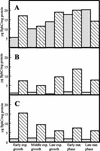Substrate specificity and expression of three 2,3-dihydroxybiphenyl 1,2-dioxygenases from Rhodococcus globerulus strain P6
- PMID: 12700274
- PMCID: PMC154411
- DOI: 10.1128/JB.185.9.2944-2951.2003
Substrate specificity and expression of three 2,3-dihydroxybiphenyl 1,2-dioxygenases from Rhodococcus globerulus strain P6
Abstract
Rhodococcus globerulus strain P6 contains at least three genes, bphC1, bphC2, and bphC3, coding for 2,3-dihydroxybiphenyl 1,2-dioxygenases; the latter two specify enzymes of the family of one-domain extradiol dioxygenases. In order to assess the importance of these different isoenzymes for the broad catabolic activity of this organism towards the degradation of polychlorinated biphenyls (PCBs), the capacities of recombinant enzymes expressed in Escherichia coli to transform different chlorosubstituted dihydroxybiphenyls formed by the action of R. globerulus P6 biphenyl dioxygenase and biphenyl 2,3-dihydrodiol dehydrogenase were determined. Whereas both BphC2 and BphC3 showed similar activities for 2,3-dihydroxybiphenyl and all monochlorinated 2,3-dihydroxybiphenyls, BphC1 exhibited only weak activity for 2'-chloro-2,3-dihydroxybiphenyl. More highly chlorinated 2'-chlorosubstituted 2,3-dihydroxybiphenyls were also transformed at high rates by BphC2 and BphC3 but not BphC1. In R. globerulus P6, BphC2 was constitutively expressed, BphC1 expression was induced during growth on biphenyl, and BphC3 was not expressed at significant levels under the experimental conditions. Although we cannot rule out the expression of BphC3 under certain environmental conditions, it seems that the contrasting substrate specificities of BphC1 and BphC2 contribute significantly to the versatile PCB-degrading phenotype of R. globerulus P6.
Figures


Similar articles
-
Multiple genes encoding 2,3-dihydroxybiphenyl 1,2-dioxygenase in the gram-positive polychlorinated biphenyl-degrading bacterium Rhodococcus erythropolis TA421, isolated from a termite ecosystem.Appl Environ Microbiol. 1995 Feb;61(2):549-55. doi: 10.1128/aem.61.2.549-555.1995. Appl Environ Microbiol. 1995. PMID: 7574595 Free PMC article.
-
Analysis of three 2,3-dihydroxybiphenyl 1,2-dioxygenases found in Rhodococcus globerulus P6. Identification of a new family of extradiol dioxygenases.J Biol Chem. 1994 Mar 11;269(10):7807-15. J Biol Chem. 1994. PMID: 8126007
-
Cloning of three 2,3-dihydroxybiphenyl-1,2-dioxygenase genes from Achromobacter sp. BP3 and the analysis of their roles in the biodegradation of biphenyl.J Hazard Mater. 2013 Oct 15;261:246-52. doi: 10.1016/j.jhazmat.2013.07.019. Epub 2013 Jul 19. J Hazard Mater. 2013. PMID: 23948567
-
Engineering dioxygenases for efficient degradation of environmental pollutants.Curr Opin Biotechnol. 2000 Jun;11(3):244-9. doi: 10.1016/s0958-1669(00)00091-4. Curr Opin Biotechnol. 2000. PMID: 10851151 Review.
-
[Molecular biology of enzymes degrading pollutants: diversity and convergent evolution observed on extradiol dioxygenases].Tanpakushitsu Kakusan Koso. 2000 Jun;45(8):1339-49. Tanpakushitsu Kakusan Koso. 2000. PMID: 10846472 Review. Japanese. No abstract available.
Cited by
-
Evolutionarily divergent extradiol dioxygenases possess higher specificities for polychlorinated biphenyl metabolites.J Bacteriol. 2005 Jan;187(2):415-21. doi: 10.1128/JB.187.2.415-421.2005. J Bacteriol. 2005. PMID: 15629912 Free PMC article.
-
Functional Metagenomics of a Biostimulated Petroleum-Contaminated Soil Reveals an Extraordinary Diversity of Extradiol Dioxygenases.Appl Environ Microbiol. 2016 Apr 4;82(8):2467-2478. doi: 10.1128/AEM.03811-15. Print 2016 Apr. Appl Environ Microbiol. 2016. PMID: 26896130 Free PMC article.
-
Assessment of Biodegradation Efficiency of Polychlorinated Biphenyls (PCBs) and Petroleum Hydrocarbons (TPH) in Soil Using Three Individual Bacterial Strains and Their Mixed Culture.Molecules. 2020 Feb 6;25(3):709. doi: 10.3390/molecules25030709. Molecules. 2020. PMID: 32041368 Free PMC article.
-
Isolation and Characterization a Novel Catabolic Gene Cluster Involved in Chlorobenzene Degradation in Haloalkaliphilic Alcanivorax sp. HA03.Biology (Basel). 2022 May 9;11(5):724. doi: 10.3390/biology11050724. Biology (Basel). 2022. PMID: 35625452 Free PMC article.
-
Biochemical and genetic characterization comparison of four extradiol dioxygenases in Rhizorhabdus wittichii RW1.Appl Microbiol Biotechnol. 2022 Sep;106(17):5539-5550. doi: 10.1007/s00253-022-12099-3. Epub 2022 Jul 30. Appl Microbiol Biotechnol. 2022. PMID: 35906995
References
-
- Asturias, J. A., L. D. Eltis, M. Prucha, and K. N. Timmis. 1994. Analysis of three 2,3-dihydroxybiphenyl 1,2-dioxygenases found in Rhodococcus globerulus P6. J. Biol. Chem. 269:7807-7815. - PubMed
-
- Barriault, D., C. Simard, H. Chatel, and M. Sylvestre. 2001. Characterization of hybrid biphenyl dioxygenases obtained by recombining Burkholderia sp. strain LB400 bphA with the homologous gene of Comamonas testosteroni B-356. Can. J. Microbiol. 47:1025-1032. - PubMed
Publication types
MeSH terms
Substances
LinkOut - more resources
Full Text Sources
Research Materials

